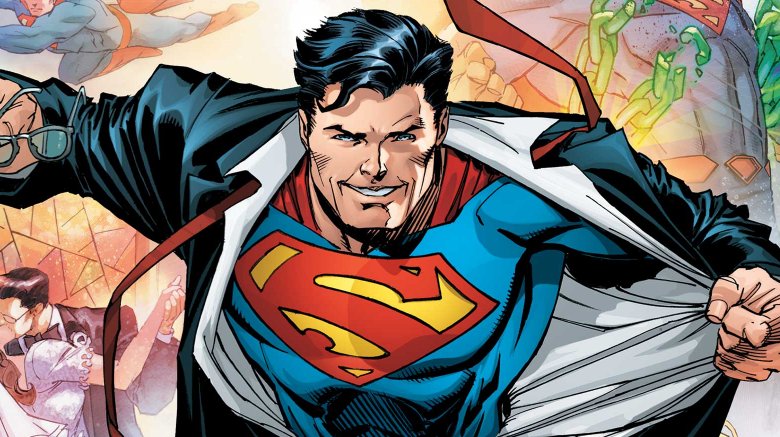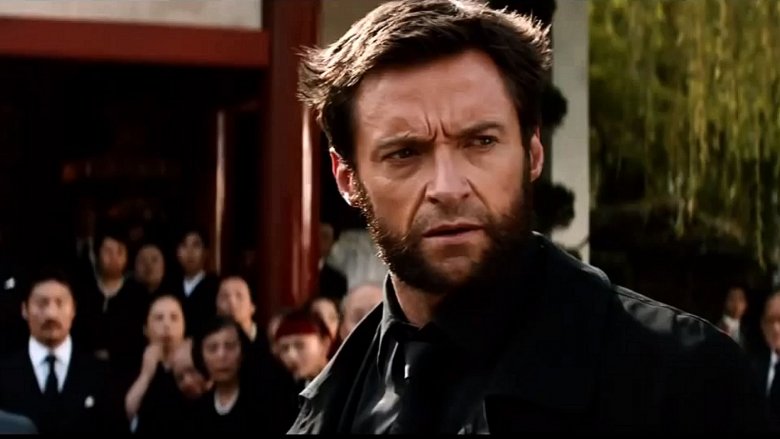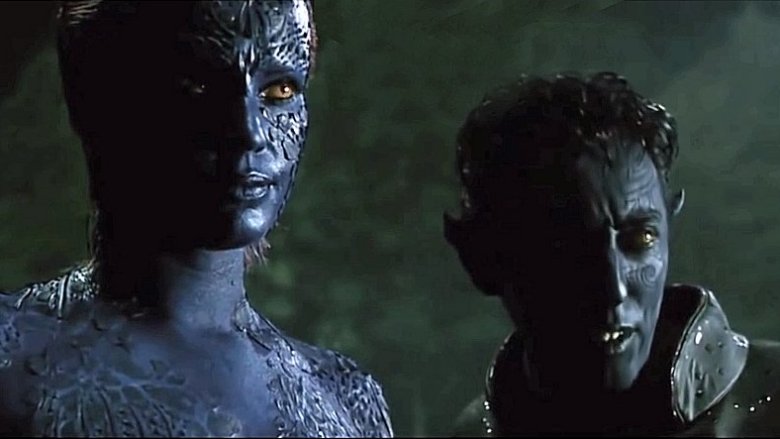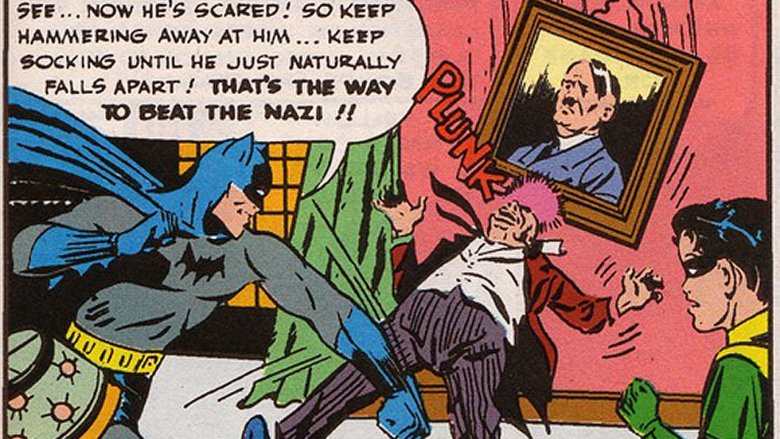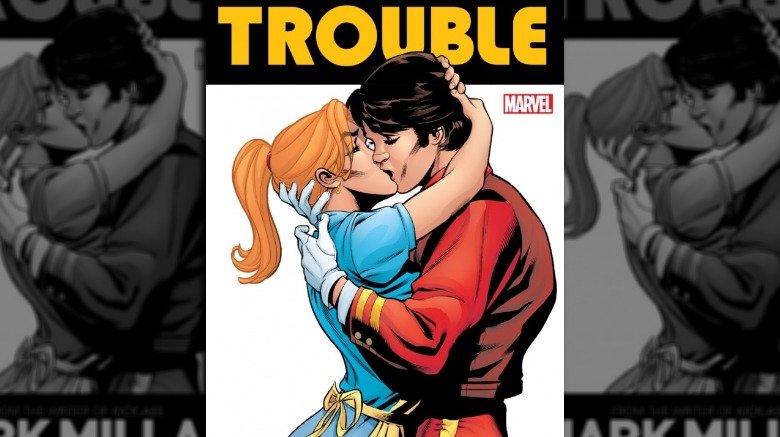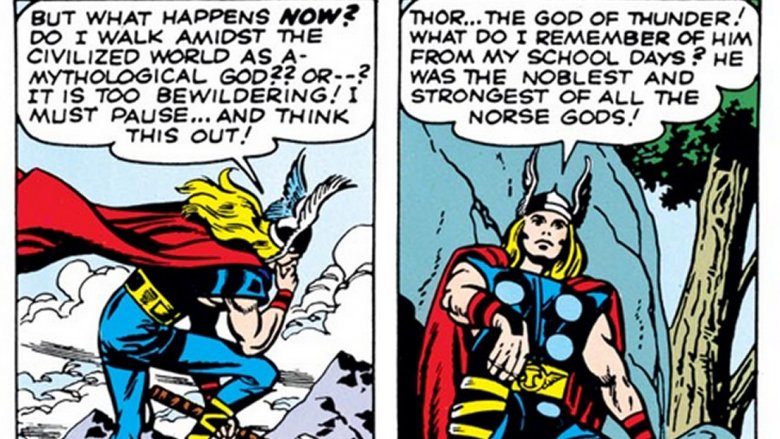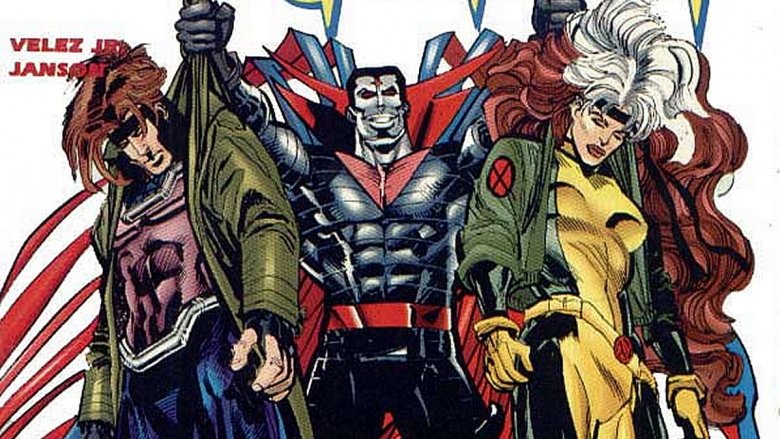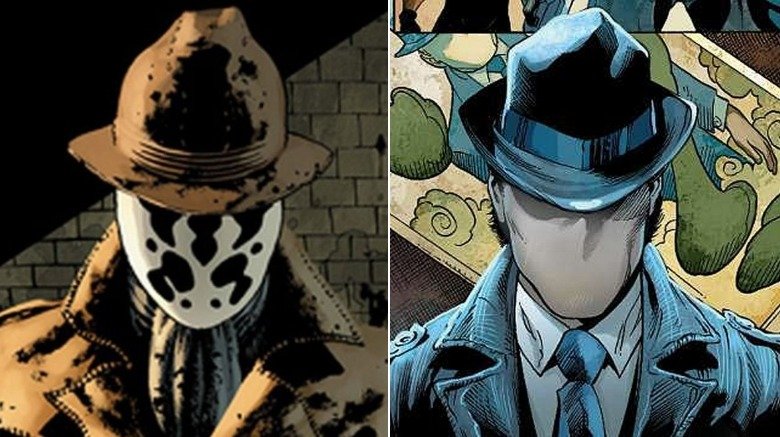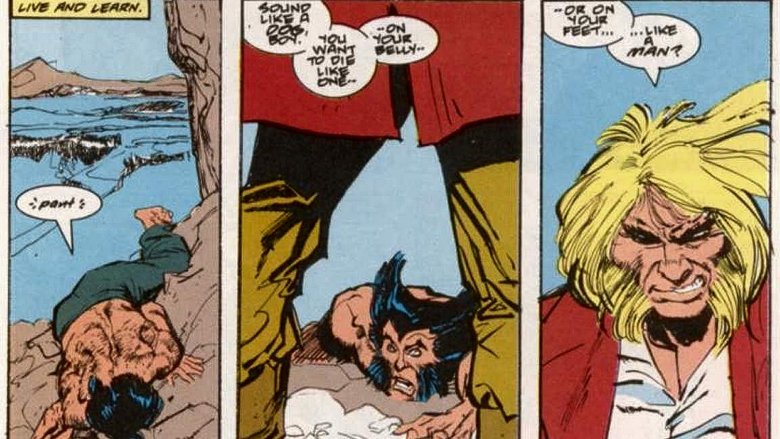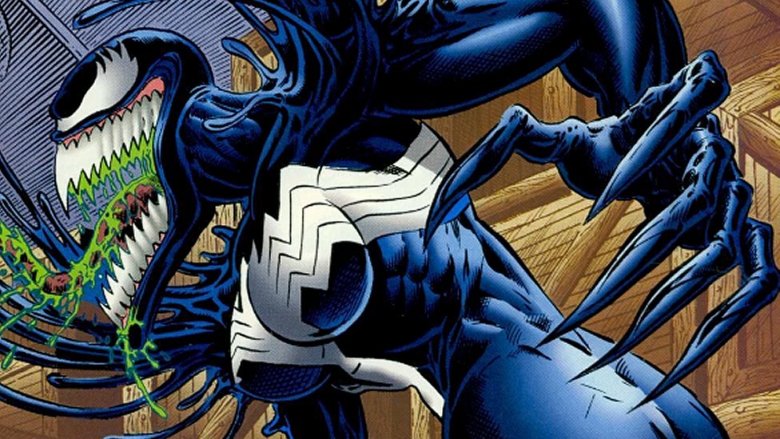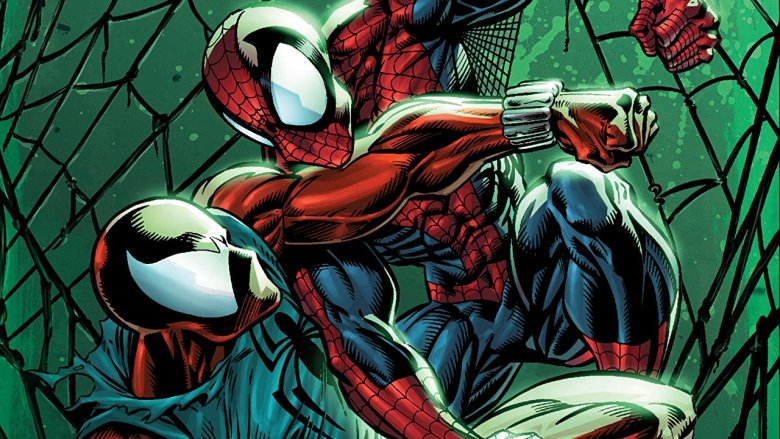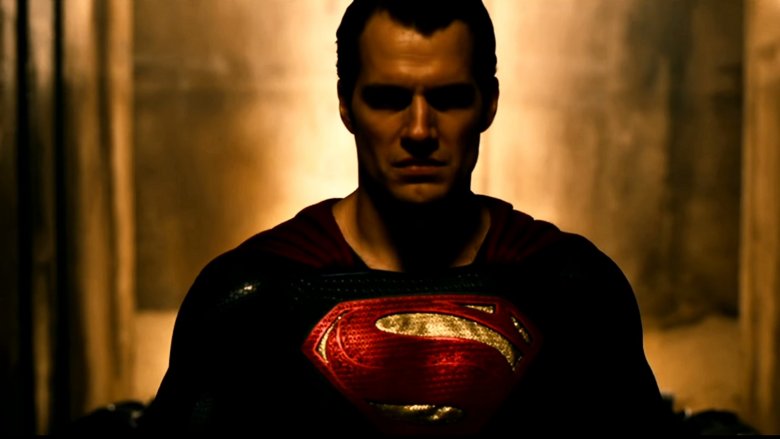Crazy Superhero Origin Stories That Were Changed At The Last Second
Hey, if you're going to get superpowers, a fancy costume, and devote your life to battling evildoers, you better have a good explanation. Origin stories are the bread and butter of superhero fables, and even when these characters get rebooted every decade, the core story tends to stay consistent. Spider-Man grabs your heart because you know what happened to his Uncle Ben. The Teenage Mutant Ninja Turtles are the result of some oozy sewer contamination. Iron Man is a rich jerk who gets dumped in a cave, fights his way out, and becomes a little less of a jerk. If you're a fan, you know 'em all.
Sometimes, though, the writers didn't get it quite right the first time. Some of the most popular superheroes and villains out there, from Wolverine to Superman, almost had radically different origin stories. If these original concepts had been approved, you wouldn't even recognize these characters today.
Wolverine was supposed to be an actual wolverine (really)
Wolverine might be the most popular X-Man ever, but boy, has his life sucked. Amnesia is bad enough, but he's also got dozens of dead girlfriends, killed his biological dad, and was turned into a nightmarish science experiment that bonded metal to his bones. Back before Marvel decided to write Logan's mysterious back story as being an eternal recurrence of loss, though, io9 says the original plan was to eventually reveal that the clawed one wasn't a real "mutant," but instead, an actual wolverine — you know, the animal — which had been transformed into a human via some nefarious mad science. That might sound like a bad joke, but according to CBR, early X-Men comics even hinted at this twist, such as one issue where Sentinel-manufacturing bad guys scan Logan's body and get weird readings from it. In a later issue, where the X-Men meet up with magical leprechauns (don't ask), Logan gruffly says he doesn't believe in such fairy tales, to which the leprechaun cheerfully retorts that he doesn't believe in "talking wolverines" either.
Thankfully, Stan Lee put the kibosh on this wacky concept, so you can thank him for ensuring that such great stories as Origin and Weapon X got to see the light of day.
Mystique was Nightcrawler's dad
For a long time, X-Men was Marvel's biggest franchise, and a lot of the credit for that goes to longtime writer Chris Claremont. Not all of Claremont's ideas made it to print, though.
For example, take Nightcrawler, the blue-skinned Catholic smoke monster everyone loved in X2: X-Men United. In the comics Mystique is his mom, but according to CBR, Claremont's original idea was for Mystique to be Nightcrawler's father. Lest you forget, Mystique is a shapeshifter, so it's entirely feasible that she could morph the necessary "equipment" to impregnate someone ... who in this case would've been Destiny, one of Mystique's fellow Brotherhood members. This plot twist never moved from subtext to foreground possibly because of the Comics Code, a puritanical censorship group (now defunct) that barred the depiction of LGBTQ+ relationships, according to the Comic Book Legal Defense Fund. By the time the Comics Code became dust in the wind, later writers had already come up with a different depiction of Nightcrawler's parentage. But if someone did bring this twist back, it wouldn't be the first retcon in comics history.
Robin's parents were going to be killed by Nazis
If you're here, you might know the classic Robin origin story: Richard "Dick" Grayson is a high-flying young circus acrobat, whose parents, the so-called "Flying Graysons," are murdered by gangsters. Devastated, young Grayson is adopted by a strange billionaire named Bruce Wayne, and his colorful Robin costume, complete with a red shirt and yellow cape, serves as a clear homage to the circus family he lost.
Robin's back story could've been way different, though. According to Old Radio Shows, a canceled 1943 Batman radio show would've changed the Flying Graysons into a pair of FBI agents who are murdered by Nazi spies. Now, while this retcon wasn't directly proposed for the comics, CBR points out that such media adaptations had a way of causing the comic storylines to be rewritten. For example, such classic Superman staples as kryptonite, Jimmy Olsen, and the Daily Planet were first created by the Superman radio show and then adapted into the comics, while Batman's iconic Batcave was introduced in a 1943 serial. So if the Batman radio series had been produced, there's a good chance the whole "Nazis killed Robin's FBI parents" storyline would've become part of the comics.
Aunt May? More like Mom
Most fans would argue that the worst Spider-Man story ever is a certain piece of excrement known as "One More Day," but just a few years before that, another story tried to ruin Spidey in a sneakier fashion. Back in 2003, according to io9, Marvel attempted to revive the long-dormant genre of "romance" comics with Trouble, a limited series depicting the wacky bedroom hijinks of four teenagers, one of whom accidentally gets pregnant — hence, "trouble." The names of these promiscuous teens? May, Ben, Richard, and Mary.
It didn't take long for readers to figure out that these characters were supposed to be Peter Parker's Aunt May, Uncle Ben, and his biological parents. The big twist in the comic, as CBR recalls, is that it's May who gets pregnant — not by Ben, but by Richard — and that this pregnancy is hushed up, with Mary taking the baby as her own. So apparently, Spider-Man was Aunt May's secret teenage love child, and in the decades since, she's been quietly frying up wheatcakes for her son while grimly keeping the truth to herself. This twist to Spidey's origins made so little sense that the book was dead on arrival, and it has never been incorporated into canon, much to everyone's relief.
Thor's whole 'Donald Blake' problem
Most of these heroes had their origins fixed before hitting print, but Thor was so confusing that Stan Lee and Jack Kirby had to work out the kinks in real time, from issue to issue. As the Sequart Organization points out, the first Thor appearance stars a character named Dr. Donald Blake, a brilliant physician with an injured leg, who discovers a mysterious magical hammer that transforms him into Thor. Amazing! Mighty! But here's the problem: Was Dr. Blake secretly Thor all along, or is Thor just an identity he assumes when holding the big hammer, a la Green Lantern's ring?
In that first appearance, it seems obvious that Dr. Blake is supposed to be the real guy. But as Lee and Kirby introduced Thor's whole cosmic family, that didn't make much sense. If Thor is really Dr. Blake, how is Odin his dad, or Loki his brother? Clearly, Lee hadn't yet figured out which way to go with the story. The crafty solution finally came in #159, which explained that some years back, Thor had become a pretty arrogant dude, so Odin had wiped his memory, and put him on Earth with a fake human identity to teach him humility. That All-Father is one serious disciplinarian, eh? It was this final version of the tale that (mostly) made it into the Marvel Cinematic Universe, though as Complex says, the "Donald Blake" identity was reduced to an Easter egg.
Mister Sinister was the creation of a little kid with an overactive imagination. So was ... Gambit?!
Buckle up, true believers, and get ready for a confusing ride.
Comic book characters often have goofy names, but "Mister Sinister" takes the cake. Combine that name with sharp teeth, pale skin, glowing red eyes, plus a spiky cape, and he seems like the sort of monster a little kid might make up, right? As it happens, that's exactly the effect writer Chris Claremont was going for. According to CBR, "Mister Sinister" was conceived as the psychic projection of a superpowered immortal being trapped in the body of an 11-year-old boy who could never age and was seriously angsty about it. This bitter kid used his oh-so-Sinister identity as a way to look big and tough. Though these origins were hinted at, the storyline was dumped when Claremont left the book, according to Benjamin Poore, and replaced by the Neo-Victorian mad scientist story now attached to Sinister today.
Hold on, though, because CBR says this tale gets even weirder. Claremont's original plan also included Sinister spying on the X-Men and developing a voyeuristic obsession with Rogue. Knowing Rogue would never fall in love with his childish body (or his vampiric monster man), the kid creates an adult clone of himself who can be with Rogue. The clone, named Gambit, would have gone on to win Rogue's heart and become one of the X-Men before his sinister origins would've been revealed.
Watchmen was supposed to feature the Question, the Blue Beetle, Captain Atom, and other Charlton heroes
Part of what made Alan Moore and Dave Gibbons' Watchmen so effective was that it took the superhero genre to places that comics had never ventured before. The heroes struggled with mental health ailments, the villain tried to "save" the world, and the good guys lost in the end. Part of what made this story possible was that the creators didn't use iconic heroes like Batman and Superman, but instead created a whole new universe to tear apart. According to Polygon, though, this wasn't the original intention.
Back in the 1980s, DC Comics purchased the rights to a bunch of superheroes previously published by Charlton Comics, including the Question, the Blue Beetle, Nightshade, and Captain Atom. Moore and Gibbons initially pitched their post-apocalyptic superhero tale as one featuring all the Charlton characters, but DC balked: After spending money on those characters, they didn't want to potentially ruin their rep in such a crazy, dark, twisted story. So Moore and Gibbons created a bunch of new characters instead, based loosely on the Charlton ones. The parallels are easy to see, as MTV points out: Nite-Owl is just the Blue Beetle, Rorschach is the Question, and so on. Still, it's crazy to imagine how comics might be different if the original version of this story had hit the stands.
Sabretooth was Wolverine's disturbed dad
Though Sabretooth, aka Victor Creed, was first introduced in an issue of Iron Fist, this scary blond dude was linked to Wolverine from early on. His whole look was a discarded Wolverine design by John Byrne, according to Mental Floss, and by the time the two started scratching each other up, Logan's spotty memory made it easy for Sabretooth to taunt him with whispers of a potential familial relation.
According to CBR, the original idea was for Sabretooth to eventually be revealed as Wolverine's ornery, abusive dad. A couple of writer changes later, though, a DNA test by S.H.I.E.L.D. proved Creed wasn't Wolverine's pop. This news was such a relief that Logan and Nick Fury shared cigars over it, and honestly, wouldn't you do the same? Nonetheless, lots of creators have toyed with biologically linking Sabes and Wolvie in various other ways, though it's never stuck. Many fans thought Origin writer Paul Jenkins intended for Wolverine's brother Dog Logan to be Sabretooth, though Jenkins himself said in a 2005 interview that he didn't see it that way, and later stories have presented Dog and Victor as different people. That didn't stop the 2009 movie X-Men Origins: Wolverine from taking the bait, though.
Venom was going to be a pregnant woman who miscarried
It takes a seriously popular supervillain to get his own movie, and Venom has one devoted fan base. In many ways, Eddie Brock makes the perfect anti-Spider-Man: While Peter Parker is the kid who grew up too fast, always plagued by self-doubt, debts, and responsibilities, Brock is the kid who never grew up, never takes responsibility, and blames others for his mess-ups. The two are so perfectly opposite that you'd imagine their storyline had been planned all along, but surprisingly enough, Brock wasn't the guy originally intended to become Venom. In fact, the character's creators weren't aiming for a "guy" at all.
According to IGN, Venom was originally conceived as a happily married pregnant woman who gets in a car accident when her taxi driver is too busy looking up at Spider-Man to pay attention to the road. Her husband dies, she has a miscarriage, and she's so enraged at Spider-Man that his rejected alien costume is drawn to her like a moth to flame. This original Venom pitch got rejected by the editor because ... uh, she was a female villain. Yeah, really. Needless to say, this sexist dismissal hasn't aged well, but at the time, it meant that writer David Michelinie had to quickly invent a new character, Eddie Brock, who has since become the symbiote's most iconic host. Other people have occasionally hopped into the black goo, though, including lawyer Anne Weying, pictured above.
Scarlet Spider wasn't a clone, but a time-traveling Peter Parker
Spider-Man's "Clone Saga" was messier than a box full of tangled Christmas lights, but the gist of the whole thing involves a grizzled motorcyclist named Ben Reilly (aka the Scarlet Spider) coming out of the blue and claiming to be Peter Parker's clone from some years back. Since Ben has spider-powers and wears a seriously cool costume, everyone believes him. Then, tests show that Ben is actually the true, original Peter, meaning the Peter readers had been following for years was a clone...
...until the fans revolted, sending the creators into a tailspin as they tried to figure out how to reverse course.
According to Andrew Goletz's fan-acclaimed "Life of Reilly" series, the Spider-writers at one point decided to fix the whole thing with a "time loop," where it would be revealed Ben wasn't actually a clone but instead a version of Peter Parker sent five years back in time by Mephisto, Marvel's version of the devil. In other words, both Ben and Peter were the real Spidey, just from different times. Voila! However, the editors vetoed the idea, pointing out that all this mystical Mephisto stuff had no place in a Spider-Man story.
Superman was originally a villain
The entire "superhero" genre as we know it rises and falls on the creation of Superman, the ultimate science fiction immigrant story, first brought to life by two Jewish kids from Cleveland named Jerry Siegel and Joe Shuster. However, History says back when Siegel first made it out of high school, he self-published a story called "Reign of the Superman," where the titular Superman character is a villainous powerhouse created by an evil mad scientist. According to the Jewish Virtual Library, Siegel and Shuster abandoned this villainous Superman concept when, over in Europe, the Nazis started distorting Nietzsche's "Superman" concept for their own purposes. In response to this, the now-legendary duo recreated their Superman character with a new origin story as a heroic force for truth, justice, and the American way: an alien from another world who protects the Earth from any evildoers stupid enough to oppose him. These days, Superman seems old school, but at the time, the character was so innovative and radical that it took five years for Siegel and Shuster to find a publisher willing to produce their story, which finally came to light in Action Comics #1.
